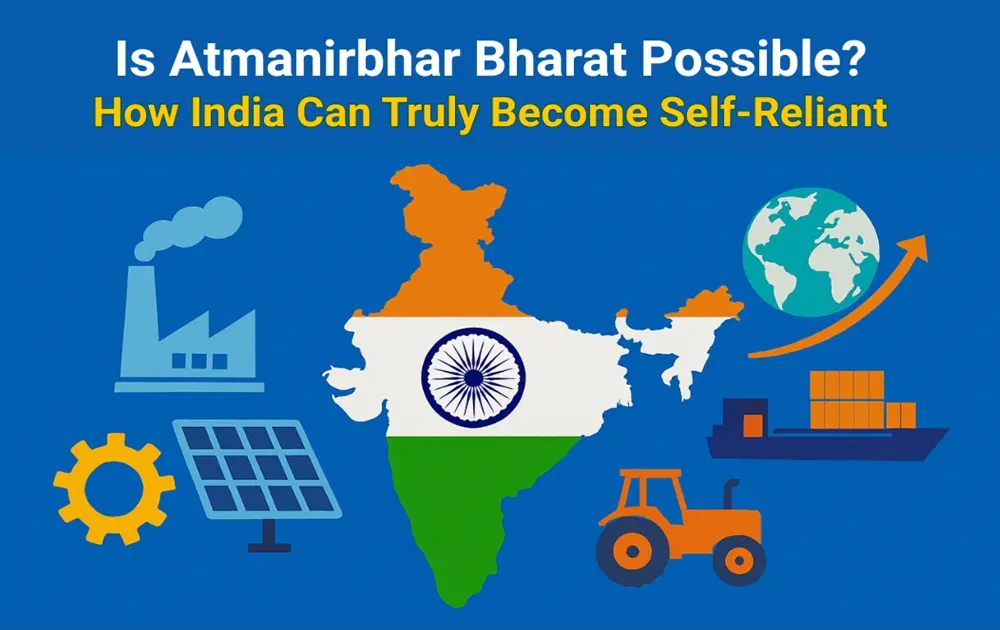Is Atmanirbhar Bharat truly possible, or just a political slogan? As India aims to become self-reliant, the challenge lies in reducing import dependency—especially on China—and building strong domestic capabilities.
From manufacturing and innovation to energy security and skilled human capital, self-reliance demands more than patriotic buying.
Let’s explore how India can realistically achieve Atmanirbharta through strategic reforms, local entrepreneurship and global competitiveness.
Whether you’re a student, policymaker, or curious citizen, understanding the roadmap to a truly self-reliant India is essential. Let’s decode the vision, the gaps, and the practical steps needed to make Atmanirbhar Bharat Abhiyan a success.

Is Atmanirbhar Bharat Possible in Today’s Global Economy? How India Can Achieve Genuine Self-Reliance?
Yes, India can achieve genuine self-reliance but it needs strong action. India must boost local manufacturing, invest in innovation, and train skilled workers. Clean energy and food security are also key. Reducing import dependency—especially on China—will help India grow independently. Real self-reliance means building strength across industries, people, and policies.
Introduction
Atmanirbhar Bharat — a phrase that entered India’s national conversation in 2020 — means more than slogans and production-linked incentives. It asks a big, practical question: can a nation of 1.4 billion reduce vulnerabilities, build resilient supply chains, grow domestic capabilities and still compete in a globally connected economy?
Self-reliance (Atmanirbharta) is often misunderstood as isolation; the smarter target is resilient interdependence — being able to produce, innovate and respond domestically for core needs while participating in global trade and technology flows.
In this article, we will walk through what Atmanirbhar Bharat actually means, the real bottlenecks (imports, skills, R&D, infrastructure and governance), the existing policy architecture (PLI, MSME support, renewable push), and concrete levers India must pull to move from ambition to measurable outcomes.
Understanding Atmanirbhar Bharat
Atmanirbhar Bharat is a policy idea and political brand rolled into one: it’s a commitment to grow domestic capacity, reduce critical import-dependencies and make India an exporter of value-added goods and technologies.
The Indian government framed it as a multi-sector programme that includes incentives like Production Linked Incentive (PLI) schemes, reforms for MSMEs, incentives for electronics and semiconductors, and easier access to finance.
But beyond policy packages, Atmanirbhar Bharat is a mindset change — it expects public procurement, private investment, entrepreneurs and researchers to prioritize domestic value creation without closing India off from global markets.
The practical goal isn’t autarky; it’s resilience. Modern economies participate in global value chains (GVCs) — parts are designed in one country, produced in another, assembled in a third.
India’s challenge is to increase domestic content in these chains for strategically important sectors (electronics, defence, pharma, energy) while remaining an attractive place for global value chain participation.
That dual strategy — build local capacity + integrate selectively into GVCs — requires aligned industrial policy, trade diplomacy, finance for scale-ups, and a long-term push on R&D and skills.
Two realities shape the task: India’s manufacturing share of GDP has room to grow compared to peers (data-series show manufacturing still under 20–18% range in recent years). And India’s R&D investment as a share of GDP remains lower than peers, limiting homegrown technological leaps.
These are solvable but need patient, sustained effort and honest measurement.
The Vision Behind the Mission
Atmanirbhar Bharat is pitched as economic sovereignty: secure supply chains, domestic job creation and technological capability.
The vision bundles near-term stimulus (job-heavy manufacturing, MSME support) with long-term goals (R&D, semiconductors, defence manufacturing).
But policy execution must match rhetoric: without measurable targets for domestic content, exports, or R&D growth, the vision risks being aspirational rather than structural.
Self-Reliance vs. Isolation
Self-reliance ≠ protectionism. Isolation chokes growth; targeted self-reliance builds buffers in essentials (energy, food, critical components) while keeping trade open.
The smart model is “resilient interdependence”: domestic capabilities for shocks, plus global partnerships for efficiency and innovation.
Current Challenges to Self-Reliant India
India’s path to meaningful self-reliance is blocked by several interlocking problems.
First, import dependence in critical areas—electronics components, semiconductors, specialized chemicals and oil—makes India vulnerable to supply shocks and geopolitical shifts. For example, much of India’s electronics ecosystem still relies heavily on imported components (industry estimates commonly cite ~70–80% of certain components being imported), leaving assembly-heavy gains without deep upstream control.
Second, structural economic issues hold back manufacturing scale-up: inadequate industrial infrastructure in many regions, fragmented MSMEs that lack scale and technology, and logistics bottlenecks that raise transaction costs. Even where factories exist, value addition is often low — assembling imported parts instead of producing high-value components.
Third, skill and R&D gaps limit the creation of indigenous technology. India’s R&D spend as a percent of GDP has historically lagged leading economies, constraining frontier innovation in semiconductors, advanced materials and biotech.
Fourth, policy and regulatory hurdles — complex approvals, uneven state-level implementation, and procurement practices that still favour incumbents — slow rapid scaling. Finally, defence and critical infrastructure still import substantial portions of high-end systems, an issue tracked by global arms transfer studies.
Addressing these challenges requires a programmatic approach: prioritize sectors with strategic impact, close capability gaps (skills, component manufacturing, R&D), and unblock governance and finance. Only then do incentives like PLI translate into sustained domestic supply chains rather than one-off investments.
China Dependency in Indian Markets
India’s push for Atmanirbhar Bharat faces a serious hurdle: deep dependence on Chinese imports.
Despite growing local manufacturing, India still imports nearly 70–80% of electronic components like semiconductors, PCBs, and mobile parts from China, making domestic assembly highly vulnerable.
Even in critical sectors like pharmaceuticals, India relies on China for around 65–70% of Active Pharmaceutical Ingredients (APIs).
The solar industry, a key driver of renewable energy, depends on Chinese modules and cells. China accounted for 94% of India’s cumulative solar PV cell imports and 93% of solar PV module shipments in FY23. Imports from China have dropped but remained high — in FY24, ~56% of solar cell imports and ~65% of module imports were still from China.
Such overreliance not only widens the trade deficit but also exposes India to geopolitical risks and supply disruptions, as seen during the 2020 border tensions when import delays hit MSMEs and electronics manufacturers.
Unless India diversifies supply chains, boosts component-level production and strengthens domestic R&D, the dream of Atmanirbhar Bharat will remain incomplete — too dependent on its largest competitor for core inputs.
Key Pillars of Self-Reliance in India
To convert ambition into results, India must build around four interlinked pillars: manufacturing scale-up, technology & innovation, energy & food security, and human capital. These four pillars make India stronger, more independent, and ready to lead in the global economy.
If India wants to turn big dreams into real progress, it needs to focus on these key areas.
Strengthening Domestic Manufacturing
Scale manufacturing needs supplier networks, cluster development, and incentives aligning domestic content.
India needs to make more products at home—like electronics, machinery, and medicines. This reduces our dependence on imports, especially from countries like China.
Programs like Make in India and PLI have already brought large factories and export orders for mobile phones, electronics and select chemicals.
But manufacturing must deepen — move from low-value assembly to domestic production of components (PCBs, semiconductors, specialty chemicals). This requires targeted capex support, supplier ecosystem building and export-oriented clusters.
When we build factories and support local industries, we create jobs and boost the economy. It also helps India become a global supplier instead of just a buyer.
Strong manufacturing means we control our own supply chains and can respond better to global disruptions.
Recent government data and analyses show electronics production and exports growing, yet component-level dependence remains a bottleneck.
Boosting Innovation and R&D
India must move beyond assembling products and start inventing them. That means investing in research, startups, and original designs.
India needs higher R&D investment (public + private) and better university-industry linkages. Seed-stage funding, translational research labs, and tax incentives for R&D can encourage domestic design of chips, industrial robots and bio-manufacturing solutions.
India must incentivize translational research (prototype → production), technology licensing, and local chip/system design to shift from assembly to IP-driven growth.
When we create our own technology—like chips, software, and machines—we own the ideas and patents. This builds long-term strength and global respect.
Innovation also helps solve local problems in smarter ways. From AI to biotech, India needs to lead, not follow. It’s about shifting from “Make in India” to “Invent in India.”
Improving Energy and Food Security
India’s growth depends on stable energy and food supplies. If we rely too much on imported oil or foreign food sources, we become vulnerable to price shocks and shortages.
Shifting to renewables, improving storage and reducing oil dependence improves resilience.
Clean energy like solar and wind can power industries without pollution or foreign dependence. Similarly, strong agriculture and food storage systems ensure everyone eats well.
Energy and food security protect both people and progress, making India truly self-reliant in daily life and development.
India has rapidly increased renewable capacity — official updates report record additions and rising installed capacity, which supports energy security goals.
Increasing Skill Development and Human Capital Management
Self-reliance isn’t just about machines—it’s about people. India must invest in education, skills, and training so citizens can work in modern industries.
Human capital means turning India’s huge population into a powerhouse of talent. Without skilled people, factories and tech won’t reach their full potential.
From coding to robotics to green farming, skilled workers drive innovation and growth. When people are empowered, they earn better, live better, and contribute more.
Targeted vocational programs, apprenticeships and lifelong skilling must supply the workforce manufacturing and tech sectors need. MSMEs must be supported to adopt digital tools and quality standards.
These pillars create an ecosystem where Make in India is matched by Make for India and Make from India.
How India Can Truly Become Self-Reliant
Moving from policy announcements to sustained self-reliance needs a three-part approach: policy & governance fixes, smarter engagement with global value chains, and inclusive, sustainable growth.
Policy Reforms and Governance
Rules must be predictable, procurement reoriented to favor domestic capacity where strategic, and ease-of-doing-business improvements must be deepened, especially at state levels. Public procurement can be used strategically (with safeguards) to build domestic champions in healthcare, defence and telecom.
Effective governance also means transparent progress metrics — domestic content percentages, import substitution rates, technology transfer targets and export growth by sub-sector.
Global Value Chains and Exports
India should not withdraw from global value chains; it should move up within them. That means negotiating technology tie-ups, attracting global lead firms to co-invest in component ecosystems, and offering targeted incentives for components that create maximum domestic value.
For instance, supporting PCB and semiconductor fabs needs longer-term, capital-intensive policy certainty.
At the same time, export push strategies must focus on quality, standards compliance and supplier consolidation so Indian exporters can reliably deliver to global buyers.
India should aim to capture higher value in GVCs — component production, design and branding. Attract long-term FDI that builds supplier ecosystems and promote exports via quality certification and trade facilitation.
Sustainable and Inclusive Growth
Growth must be sustainable and inclusive: green industrial policy (renewable + storage + manufacturing of green tech), financing for MSMEs to scale, and social safety nets to support transitions.
Finance instruments — long-tenor debt, blended finance, and export credit — will be decisive in turning factories into globally competitive businesses.
Green manufacturing, rural industrialization and financial inclusion ensure Atmanirbhar Bharat benefits wide sections. Align incentives with sustainability goals (clean energy inputs, circular manufacturing) to create durable exports and domestic markets.
Is Complete Self-Reliance Realistic?
If by “complete self-reliance” we mean India producing every critical good domestically and cutting all trade ties — that’s neither realistic nor desirable.
The modern global economy is interdependent by design: no country independently manufactures everything efficiently.
Attempting full autarky would mean higher consumer prices, slower technological diffusion, and lost export opportunities.
A more achievable and sensible goal is strategic self-reliance: ensure domestic capacity for essentials and critical inputs (food, basic medicines, select electronics components, certain defence systems, energy buffers) while remaining open for trade and technology collaboration.
Strategic self-reliance reduces vulnerability to supply disruptions and geopolitical pressures, without sacrificing the productivity gains from trade.
The realistic path requires prioritization. India should identify a short list of strategic sectors where domestic depth matters (semiconductors to an extent, active pharma ingredients where supply concentration is a risk, certain defence systems, medical devices, and renewable energy components).
For these, the state can co-invest (public-private partnerships), offer long-term contracts and catalyze ecosystem suppliers. For other sectors, India should focus on competitiveness and export-driven integration.
Time horizon matters: building semiconductor fabs or a robust domestic chemicals base is capital and time intensive — expect decades for full maturation. But intermediate wins are visible: India’s electronics production and exports have surged in recent years, and renewable capacity additions have been strong.
Strategic self-reliance is achievable if India sustains policy clarity, investment, and industrial diplomacy.
Can India Build Atmanirbhar Bharat Without Breaking China Ties?
Yes, India can pursue Atmanirbhar Bharat without completely cutting off ties with China — but it requires a smart, balanced approach.
The truth is, China is deeply embedded in global supply chains, and suddenly disconnecting would hurt Indian industries, especially electronics, pharma, and solar energy.
Instead of a full break, India needs to reduce overdependence on Chinese imports by building strong local ecosystems, investing in R&D, and diversifying suppliers across countries like Vietnam, Taiwan, and South Korea.
At the same time, India can continue trading in non-strategic sectors where it benefits from cost efficiency.
Think of it like this: you don’t need to stop talking to a neighbor, but you should avoid depending on them for everything important.
By mixing self-reliance with selective cooperation, India can stay globally connected while protecting its critical industries and moving closer to true economic resilience.
What can We Do to Make Atmanirbhar Bharat Abhiyan Truly Successful?
To make Atmanirbhar Bharat Abhiyan truly successful, India needs action at multiple levels — government, industry, and citizens.
Success will come when policy support, private investment, and public participation move in the same direction — building a self-reliant India that is globally competitive, not isolated.
Here are 10 easy-to-understand tips to make Atmanirbhar Bharat work in real life:
1. Support Local Manufacturing
Buy Indian-made products and promote local brands. This helps factories grow, creates jobs, and reduces our need to import goods from other countries like China.
2. Invest in Innovation
Encourage startups, research, and new ideas. When India builds its own technology, we become stronger and less dependent on foreign inventions or patents.
3. Skill the Workforce
Train people in modern skills like coding, robotics, and green farming. A skilled population powers industries and helps India compete globally.
4. Improve Infrastructure
Better roads, ports, and the internet help businesses grow faster. Strong infrastructure makes it easier to produce, transport, and sell goods across India and the world.
5. Ease Business Rules
Simplify taxes, licenses, and approvals. When starting and running a business is easy, more people will invest and create jobs.
6. Strengthen Agriculture
Support farmers with technology, fair prices, and storage. A strong farming system ensures food security and reduces rural poverty.
7. Expand Clean Energy
Use solar, wind, and bioenergy to power industries. Clean energy reduces pollution and cuts our dependence on imported oil and coal.
8. Promote Local Brands
Use social media and campaigns to highlight Indian products. When people know and trust local brands, they choose them over foreign ones.
9. Diversify Trade Partners
Don’t rely too much on one country for imports or exports. Building trade with many nations makes India safer from global shocks.
10. Educate Citizens
Teach people why self-reliance matters. Awareness leads to action—when citizens understand the mission, they support it with their choices and voices.
Read Here: Social Impacts of High Taxation on Salaried Indians
Conclusion — Final Verdict
Is Atmanirbhar Bharat possible? Yes — but only on India’s terms: strategic self-reliance, not isolation.
The nation has scale, entrepreneurship, rising electronics production, record renewable additions and an improving policy toolkit. Yet gaps in R&D spending, component-level manufacturing, and certain governance bottlenecks are real.
My verdict: India can become materially more self-reliant within a decade in targeted sectors (electronics assembly + components, renewables, selected pharma inputs, and defence subsystems) if it (a) commits sustained R&D funding, (b) builds supplier ecosystems (PCBs, IC packaging, specialty chemicals), (c) uses procurement and finance smartly, and (d) prioritizes skills.
Full autarky is neither desirable nor feasible. But a resilient, globally competitive India — able to withstand shocks and export value-added goods — is achievable.
The test will be consistency: policy continuity, honest metrics, and a willingness to invest now for payoffs later.
Author: Mahtab Alam Quddusi – A Passionate Writer, Blogger, Social Activist, Postgraduate in Sociology and Social sciences and Editor of The Scientific World.





